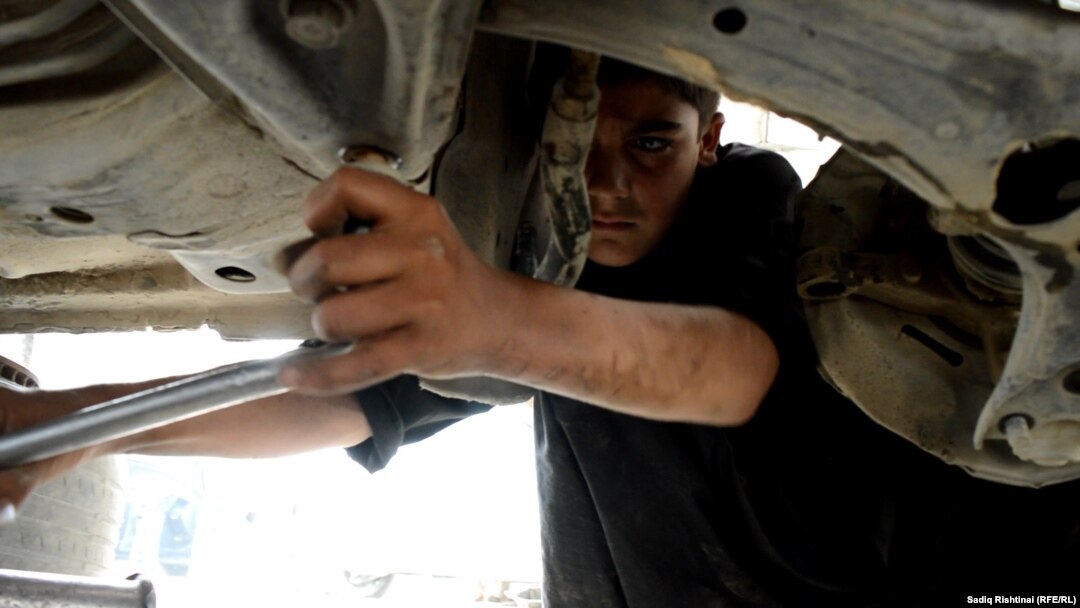Ghulam Ali earns up to $2 per day selling vegetables from a wooden cart he hauls around the Afghan capital, Kabul.
Ali is only 14 years old, but he is the sole breadwinner for his family. With his father unable to work due to ill health, Ali was forced to drop out of school last year and earn a living.
"A year ago, I studied and worked sometimes," Ali, who was in the eighth grade, told RFE/RL's Radio Azadi. "But this year, I need to work regularly."
Ali is among at least 1 million children working in Afghanistan, where incomes have plummeted and millions are on the brink of starvation. Many child laborers polish boots, wash cars, beg in the streets, or work in mines.
The number of child laborers has spiked since the Taliban seized power in 2021, which aggravated an already major humanitarian crisis and triggered an economic collapse that led to soaring inflation and mass unemployment.
The United Nations estimates 6 million Afghans are on the brink of starvation and an additional 28 million people need urgent humanitarian assistance.

Many Afghan children work in auto repair shops.
The Taliban's severe restrictions on female employment, including a ban on women working for local and foreign NGOs, have also contributed to the rise in child labor.
Female-led households have relied on cash and food assistance from aid agencies to survive. But many have been forced to fend for themselves after foreign NGOs cut their operations after a ban by the Taliban came into effect in December.
Sami, whose father died several years ago, picks through garbage dumps in the western city of Farah looking for recyclable plastic and metal he can sell. On a good day, he earns 50 cents per day.
With his family largely closed off from humanitarian aid, Sami has been forced to work on the streets.
Afghan children work at a brick factory on the outskirts of Kabul.
"I'm only 13, and there are six of us at home," he told Radio Azadi. "I cannot meet the expenses of the house. We need help."
Desperate Parents
Up to one-fifth of families in Afghanistan have been forced to send their children to work, according to a 2022 survey by Save The Children.
"If just one child in each of these families is being sent to work, then more than one million children in the country are engaged in child labor," the London-based organization said.
Another survey found that 29 percent of female-led households in 2022 had at least one child engaged in child labor, up from 19 percent in 2021. In male-led households, the figures jumped from 13 to 21 percent.
An Afghan girl works at a brick-making factory in Nangarhar Province.
Nisar Ahmad Kohin, an Afghan child rights expert, told Radio Azadi that "neglecting the future of our children will only destroy the future of our country."
Activists have called on the Taliban to curb child labor. But the militant group has not outlined any plans to address the issue.
The number of child laborers is only likely to grow as the dire economic and humanitarian crises worsen in Afghanistan.
Last month, the UN said around 85 percent of Afghans were living below the poverty line. The figure represents a huge increase of 15 million since 2020, when the Western-backed Afghan government was still in power.
An Afghan boy works at a coal mine in Samangan Province.
Habibullah owns a car repair shop in the central province of Bamiyan. He said parents desperate to feed their families are increasingly sending their children to work.
"Every day, parents come and ask me to take on their children as apprentices," Habibullah told Radio Azadi. "The economic conditions are forcing people to sacrifice their children's education [and send them to work]."
Mira Jan Rasikh, a social worker in Bamiyan, said the Taliban should take responsibility. "The government is obliged to protect children from a life of toil," he told Radio Azadi.


